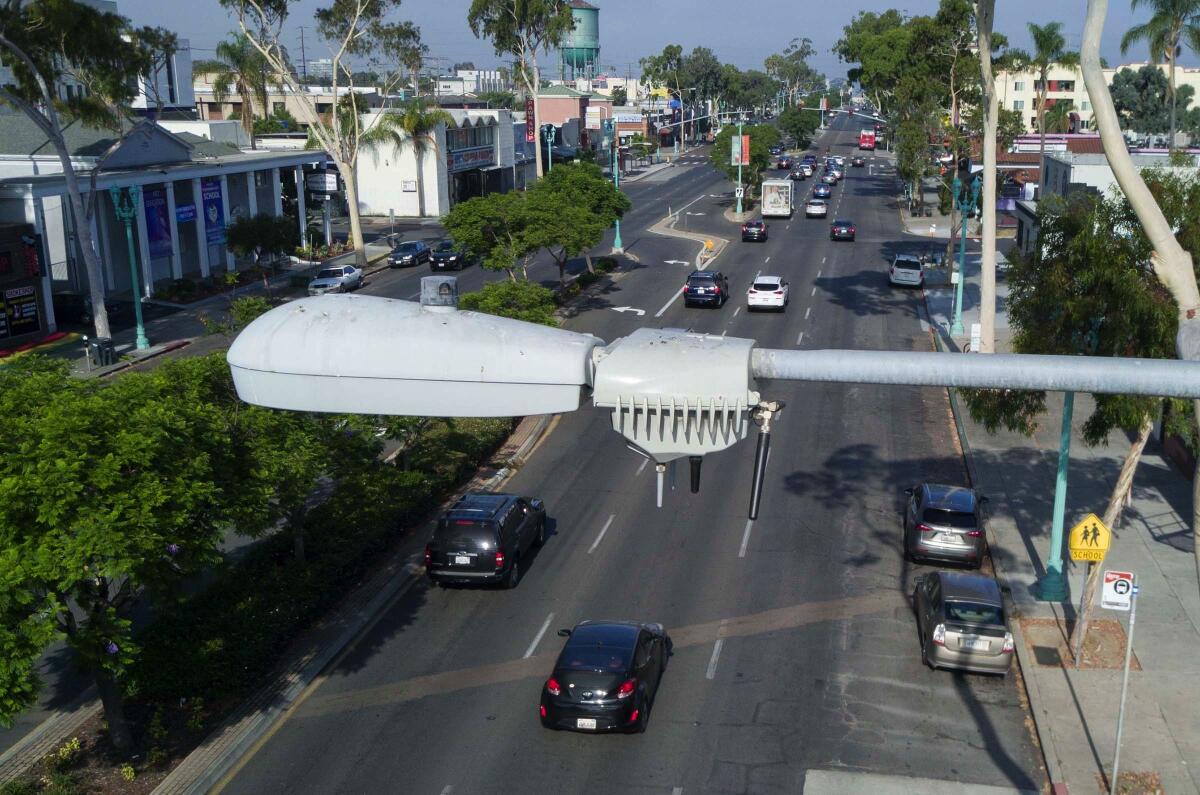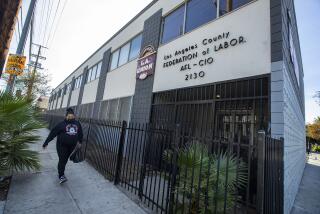Showdown expected over data collected from San Diego’s eye-in-the-sky streetlights

SAN DIEGO — Amid pushback following the revelation that there are data-gathering sensors on thousands of local high-tech streetlights, a San Diego city committee will get its first look at a potential policy governing how all that data is accessed and used.
On Wednesday, the proposed policy will be discussed by San Diego’s Public Safety & Livable Neighborhoods committee. It’s the first step to putting the policy in front of the City Council. The policy, if ultimately OKd, will mark the first time the city codifies how the data is used and who gets to view the surveillance footage the sensors gather.
In a written report to the committee, Cody Hooven of the city’s Sustainability Department said the policy will “create guidelines for the data generated by the City’s streetlight sensors.” That, she said, includes “proper use, access and dissemination” of the data.
Among the key points in the proposed policy, as laid out in a staff report to the committee:
- The city would not be able sell the sensor data, nor could it be transferred to anyone without the city explicitly asking that it be done;
- No public access to the footage;
- The cameras cannot be upgraded to allow for facial recognition or automatic license plate reading; and
- Oversight would be created, requiring regular reporting on the data use.
On Tuesday, City Attorney Mara Elliott held a news conference praising the data-gathering lights, noting their role in solving recent violent crimes, including the arrests of two men accused of gunning down an Alpha Project security guard last month. She also used the occasion to fight back against criticism that the program allows unfettered surveillance with little oversight.
“To date, police have used streetlight recordings to help solve nearly 250 crimes, including murders, sexual assaults, kidnappings, carjackings, arson and hate crimes,” said Elliott, as she stood near the spot where the guard was killed. “Yet now a small group is telling a bunch of lies about smart streetlights to try and shut them down.
“I may be the only elected official in San Diego who is not intimidated by their scare tactics. I’m not going to turn my back on a powerful crime-solving tool that removes murders and rapists from our streets.”
Opponents of the streetlights program were quick to interject, holding an impromptu news conference of their own following Elliott’s presentation.
“This has never been about not allowing law enforcement to use the technology for a law enforcement effort,” said Genevieve Jones-Wright, who heads a coalition known as TRUST San Diego that is pushing back against the data-gathering program. “It’s been about transparency and responsible use.”
Jones-Wright said the group’s demand is for an ordinance, not just a policy, as well as for strict public oversight of the program.
“From the very beginning, we have asked for a moratorium on the use, acquisition and further installation of the smart streetlights unless and until we have an ordinance that provides for proper mechanisms to ensure transparency and accountability,” she said Tuesday.
The battle over smart streetlights has become an election issue for Elliott and attorney Cory Briggs, who is running to take Elliott’s seat. That tension made its way into the dueling news conferences, and Jones-Wright said she believed Elliott’s decision to hold the news conference was politically motivated.
Her group has previously called on Elliott to recuse herself from any decisions related to the Smart Street Lights Program because she reported owning General Electric stock on her annual statement of economic interest. GE owns the startup that has been installing the sensors.
Elliott says she owns $18,000 worth of stock and “out of an abundance of caution” asked the attorney for her campaign to review her actions to see if she had done anything incorrectly that would represent a conflict of interest.
“And of course there was not,” she said. “So an attack on my reputation for political purposes and to put the safety of San Diego aside is ridiculous and this woman works for my competitor.”
Jones-Wright quickly denied that she works for Briggs.
San Diego police say the streetlight images have helped them solve several cases, including the Nov. 6 shooting at an Otay Mesa Church’s Chicken restaurant that left one person dead and two others injured, because they were able to view footage taken from the overhead cameras. Chief David Nisleit has called them a “game changer.”
Police can access the footage only in serious cases, such as homicides. Since August 2018 through last week, police have accessed the sensor footage 246 times.
Critics say they are not opposed to public safety. What they fear is intrusive surveillance. Some worry that the video and data from the sensors might be misused against marginalized communities.
In a report to the Public Safety and Livable Neighborhoods Committee, Elliott’s office explained that audio and video recordings generated by the streetlight cameras cannot be accessed by the public or a third party, except in the case of a court order or “lawfully executed subpoena.”
However, so-called event data, defined as anonymous, alphanumeric code that is stored on the city cloud, can be accessed by the public, the report states. Such data, Elliott’s office says, contains no personal identifying information. “So while a camera may record an image of a red Subaru, the Event Data reflects only that a vehicle of a certain size drove past the streetlight at a certain time in a certain direction and at a certain speed,” the report explains.
At first, the smart streetlights were sold to the City Council and public simply as energy-saving LED lights, a way to replace thousands of old lights and save perhaps $125,000 a month.
Much later came the revelation that some smart streetlights were more than lights. As of now, some 3,200 poles include sensors equipped to gather images that are turned into data. (Sensors on an additional 1,000 poles are planned for installation this year.) The idea is to help the city “better understand the urban environment,” Hooven wrote to the committee. A city map online shows locations from as far north as Rancho Bernardo to just north of the Mexican border.
Critics have asked the city to hold off on installing additional smart streetlights until rules regarding the data are in place, as well as strict public oversight.
The streetlight poles are equipped with cameras, microphones and other technology to collect data such as pedestrian and vehicle movements, parking availability, temperature and humidity. That is turned into into alphanumeric data. The city says it can use that data in real time for community benefit, including improving traffic congestion, making parking easier or enhancing public safety.
In some corners, news that the city was gathering data sparked suspicion. The pushback follows two general tracks. Some pointed to surveillance concerns. Others worried that the city signed a contract that would allow the processed data to be mined for profit in the private sector. San Diego officials have said the city owns the source data from the sensors and that they are not selling it off or spying.
The city has also said that the audio capabilities only measure decibel levels, and the cameras focus on public property, and do not pan, tilt or zoom. The technology, the city said, does not include facial recognition nor can it read license plates. All footage is deleted after five days.
Despite officials’ praise regarding the public safety aspects of the smart streetlights, Wednesday’s proposed policy will be presented to the committee by the city’s Sustainability Department, not police (who already have an internal policy governing use and access to the images).
In a staff report to the committee, Hooven said officials held several community forums about the data-gathering, and the policy was crafted with public feedback in mind.
More to Read
Sign up for Essential California
The most important California stories and recommendations in your inbox every morning.
You may occasionally receive promotional content from the Los Angeles Times.












